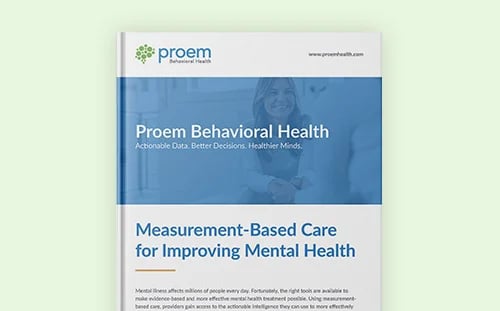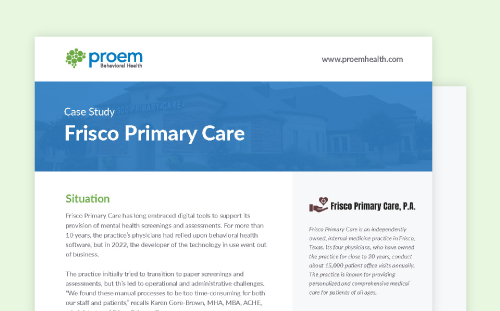The U.S. faces a growing crisis of substance abuse in adolescence. Between 2019 and 2021, the median number of monthly overdose deaths in 10- to 19-year-olds increased by 109%. Approximately 41% of those who died had evidence of mental health conditions.
.jpeg?width=768&height=432&name=AdobeStock_286988138%20(1).jpeg)
Through routine behavioral health screenings and substance use assessment, clinicians can save the lives of many adolescents while helping protect the future of many more. To provide effective interventions, clinicians must understand the factors that drive substance abuse in adolescence and why they are so important.
Consequences of SUD in Adolescence
Risky levels of substance use are damaging at any developmental stage, but adolescence is a particularly vulnerable time in one’s life. Research suggests that excessive substance use compromises the nerve connections responsible for learning and executive control.
This kind of damage is particularly problematic for adolescents, who are in a critical period for higher-order thinking. In its advisory on adolescent substance use, the Substance Abuse and Mental Health Services Administration (SAMHSA) noted, “Adolescents with untreated or undertreated substance use disorder (SUD) are at risk for experiencing adverse outcomes into adulthood, including criminal involvement, sexually transmitted infections, unintended pregnancy and co-occurring mental disorders. Furthermore, adolescent substance use is associated with violence and unintentional injury — two of the leading causes of death for this population.”
Subclinical levels of substance use also have destructive potential for adolescents. Researchers have associated drug use before age 15 with poorer cognitive performance, abnormal brain functioning and higher rates of depression. Early drug use is also a reliable predictor of SUD in later adolescence and beyond.
Fortunately, since adolescence is such a sensitive time neurologically, it’s also a prime developmental period for effective treatment. According to a 2018 study, “The adaptive nature of critical period plasticity also makes adolescence a time when informed interventions could positively affect or correct outcomes in adulthood.”
Factors Contributing to Adolescent Substance Use
The combination of peer pressure and incomplete development of the logical brain are well-known contributors to substance abuse in adolescence. However, individual experiences and mental health stressors play a more significant role for many young people. Clinicians must understand these factors to fully grasp and appreciate the need for regular screening and assessment.
Adverse childhood experiences: trauma and substance abuse
Adverse childhood experiences (ACEs) are potentially traumatic experiences before one turns 18. ACEs are generally categorized into three groups: abuse (e.g., physical, emotional, sexual), neglect and household challenges, such as parental mental illness or household substance use.
According to Counseling Today, each positive ACE doubles the likelihood that an adolescent will use substances. In addition, those with four or more ACEs are highly vulnerable to addiction, and survivors of childhood trauma are four times more likely than the general adolescent population to develop an alcohol-related disorder.
These findings highlight the promising effect of identifying and treating mental health issues and trauma histories to decrease adolescent substance use.
Co-occurring mental health conditions
Co-occurring mental health conditions are extremely common among young people with substance use issues. More than half of adolescents with mental and behavioral health disorders also have a diagnosable substance use disorder.
Researchers have found multiple connections between depression, anxiety and substance abuse. One study explored the link between social anxiety and substance abuse disorders, finding that “youth with social anxiety are likely to spend less time interacting with their peers because of their avoidant behavior, in comparison to youth with other anxiety disorders. The avoidance of peer interaction, in turn, may decrease substance use involvement.”
However, the same study also found that higher levels of generalized anxiety disorder and panic disorder were associated with more substance use for African American boys, underscoring to the need to distinguish between different anxiety disorders and consider both gender and race/ethnicity when examining the relationship between anxiety and substance use during adolescence.
Among respondents to the 2021 National Survey of Drug Use and Health, nearly 28% of adolescents who had a major depressive episode (MDE) in the past year had used illicit drugs. By contrast, only about 11% of those without a past-year MDE had done the same.
Among adolescents with MDE and substance use disorder, 56% had received treatment for either condition. However, the vast majority — 93.5% — had received only mental health services, leaving substance use unaddressed. Experts have also found that many SUD programs fail to address mental health conditions, which then persist and worsen after SUD treatment.
Adolescents with co-occurring disorders need support from substance use disorder clinics and mental health providers that work together, providing expert treatment for both issues.
A Multidisciplinary Approach to Treatment
The National Institute on Drug Abuse (NIDA) recommends a customized, multidisciplinary approach to adolescent SUD. For example, if the young person has co-occurring mental health disorders or a history of trauma and substance abuse, the treatment team must include experts on each presenting issue.
The National Child Traumatic Stress Network (NCTSN) has noted that “few treatment providers are proficient in the multiple areas of need among youth with co-occurring disorders.” Substance abuse providers, for example, may not have the tools necessary to identify the intersection of trauma and substance abuse and may not have experience or training in using trauma-informed interventions. However, trauma treatment specialists might overlook signs of increasing substance use.
In other words, interventions should strive to address all presenting issues from day one, with the ongoing involvement of family and community members. The journey often starts with routine screening.
The Importance of Early and Universal Screening
In a Journal of the American Academy of Child and Adolescent Psychiatry article, researchers note, “When faced in a clinical setting with an adolescent suspected of or known to have a substance abuse problem, it is important to integrate the assessment process with treatment decisions.“ Researchers advocate for “the use of screening instruments as a brief first step for the assessment of drug use before moving, if necessary, to the second step of comprehensive assessment of problem severity.”
However, not all adolescents with SUD or risky substance use will present with substance use as their primary problem. Therefore, NIDA urges primary care providers to ask adolescents about substance use at annual exams and other scheduled visits. Likewise, in SAMHSA’s advisory publication, the American Academy of Pediatrics recommends universal screenings for adolescent substance use in the primary care office.
A brief and age-appropriate screening can determine whether additional assessment and treatment are necessary. According to the Centers for Disease Control and Prevention, 89% of youth under 18 have an annual well-child checkup. Universal screenings at these visits could catch many more instances of risky substance use than screenings of “at-risk” adolescents alone. NIDA has also noted that any positive screening should also prompt providers to assess for abuse, suicide risk, violence and other mental health conditions.
Screening allows providers to not only identify an active SUD but also flag lower levels of use. Routine screening and assessment are key first steps to getting young people into treatment. These screenings must happen in mental health centers, substance use disorder clinics and primary care offices.
Therefore, efficient, age-appropriate behavioral health tools are essential, enabling clinicians to integrate screenings into existing workflows.
Get Support for Adolescent SUD Screening and Treatment
Proem’s evidence-based, validated digital assessment tools provide ample options for screening for substance abuse in adolescence , and our behavioral health workflow solution makes it easy for SUD clinics to screen for multiple conditions using only one platform. With multi-dimensional tools, SUD clinics and providers can seamlessly evaluate co-occurring disorders to recommend more appropriate, data-based treatment. Together, we can make progress toward mitigating the substance use issues affecting our youth. Connect with Proem today to learn how we can help.





.png)
.jpeg)








